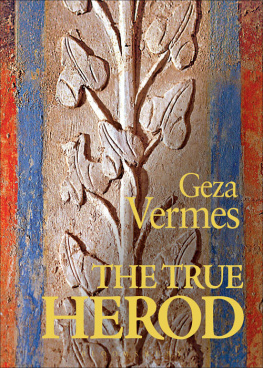JOSEPHUS
The Jewish War

TRANSLATED BY
G. A. WILLIAMSON
REVISED
WITH A NEW INTRODUCTION,
NOTES AND APPENDIXES,
BY E. MARY SMALLWOOD

Contents
|
|
Herods Predecessors |
Herods Rise to Power |
Herod Master of Palestine |
Herods Murder of Mariamme and her Children |
Herods Murder of his Heir, and Death |
The Rise and Fall of Archelaus |
Judaea under Roman Rule |
War Clouds |
The Outbreak of War |
Josephus Governor of Galilee |
The Coming of Vespasian and Titus |
Josephus the Prisoner of Vespasian |
Vespasians Conquering Advance |
Factions in Jerusalem |
Atrocities in the City. Vespasians Intervention |
Vespasian Emperor |
The Siege of Jerusalem First Stages |
Two Walls Captured |
The Horrors of the Siege |
Antonia Captured and Destroyed |
The Temple Burnt and the City Taken |
Jerusalem Destroyed: Roman Celebrations |
Cleaning-up Operations
|

THE JEWISH WAR
ADVISORY EDITOR: BETTY RADICE
JOSEPHUS was born in about 37 A.D. He was one of the Jewish leaders at the time of the revolt of the Jews in the reign of Nero. He commanded in Galilee and was captured by the Romans, but his life was spared. Spending the rest of his life in Rome, he was given Roman citizenship and became a friend of Titus and Vespasian. His two most important works are The Jewish War and The Jewish Antiquities
G. A. WILLIAMSON was born in 1895 and was a Classical Exhibitioner at Worcester College, Oxford, graduating with a First Class Honours degree. He was Senior Classics Master at Norwich School from 1922 to 1960. He also translated Eusebius: The History of the Church (1965) and Procopius: The Secret History (1966) for the Penguin Classics. He died in 1982.
E. MARY SMALLWOOD was born in 1919 and was a Classical Scholar at Girton College, Cambridge, graduating with a First Class Honours degree in 1942. She was later a Research Fellow at Girton College, where she obtained her Ph.D in 1951. Since then she was on the staff of the Queens University of Belfast, where she held a Personal Chair as Professor of Romano-Jewish history from 1978 until her retirement in 1983. Two of her other books are listed in the bibliography.
Foreword to this Edition
THE translation here given is that of the first edition, Mr Williamsons eminently lucid and readable rendering, unaltered except for minor amendments, mostly merely editorial. His division of the work into twenty-three chapters, unrelated to the seven books of the original, presents it in much more easily digestible chunks than Josephus does.
The familiar Hebrew forms of Old Testament names such as Elijah are substituted for Josephus Grecized forms, and the name Jesus, common in his period, is given its Hebrew form Jeshua. The historian, however, is referred to by the Greek/Latin form of his name, Josephus, to distinguish him from other men with the same name, who appear as Joseph. I have taken the liberty of correcting Josephus mis-spelling of Sosius and Cerealis throughout.
In the notes (pp. ) I have attempted to explain historical and other allusions which are likely to puzzle the non-specialist and make it difficult for him to follow the story. In the interests of brevity I have frequently made categorical statements unsubstantiated by evidence; full argument or documentation seems inappropriate here. It would have been easy and tempting to produce copious notes to pp. 27149, where the Antiquitates Judaicae (AJ) overlaps the Bellum Judaicum (BJ), giving the parallel references in the AJ and the differences between the two accounts. But I have tried to resist that temptation, and to confine such references to essential or highly significant additions or variations in the AJ. The Loeb edition of AJ xiixx, has full and valuable notes. My notes also include many cross-references within the BJ, in the hope of saving time and reducing the frustration of search for the reader.
To avoid repeated explanations or back-references to earlier notes, a few frequently used technical terms are explained in a glossary. Questions which would have produced cumbersome notes, points which are interdependent, explanations of recurrent details, and some peripheral matters are relegated to appendixes.
As regards the introduction, the student seeking enlightenment on the finer points or deeper questions of Josephan scholarship will look in vain for it there. The introduction is designed, like the notes and other aids, for the general reader to whom Josephus is as yet a closed book and the ancient world as a whole is largely unfamiliar territory. It is no more than an attempt to set the writer and his works in their context, to explain some facets of ancient historiography which the newcomer may find strange, and to guide the reader towards some assessment of Josephus as a historian. After that the reader is left to encounter the BJ for himself and to form his own judgement on it.
Belfast E. MARY SMALLWOOD
September, 1979
Introduction
JOSEPHUS LIFE
THE Bellum Judaicum, The Jewish War, was the first written of the four works of Josephus which have come down to us. In the course of it he describes, at disproportionate length, his own by no means wholly creditable exploits as commander in Galilee in A.D.667. In that account he says not a word about his personal enemy, Justus, son of Pistus, from Tiberias, and their differing attitudes and policies. But some twenty years after the publication of the BJ Justus also produced a history of the war (not extant) which contained what Josephus regarded as such a distorted picture of his command that he felt impelled to produce the short work misleadingly called the Vita, his life, to clear his name. This composition is no full and balanced autobiography but is little more than a detailed account of his command, written with the avowedly apologetic purpose of defending himself against what he saw as slanders by Justus, very much longer even than the account in the BJ (though the siege of Jotapata, which provides one of the most extensive purple passages in the earlier work, gets only a few passing references). It is prefaced by a brief survey of his earlier life (five pages out of a total of eighty in the Loeb edition) and rounded off with an even shorter sketch of his fortunes after 67. But thanks to the first and last few pages of this distinctly unsatisfactory work, we have more detailed, and (presumably) reliable, information about the personal life of this historian than we have about many other ancient writers.














